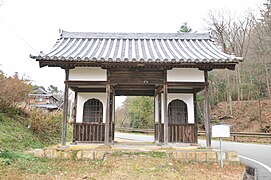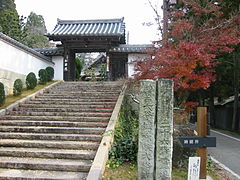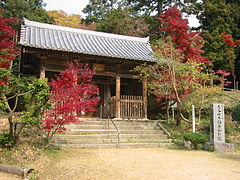Gaya-in
The Gaya-in ( Japanese 伽耶 院 ), also called Daikei-ji (大谿 寺), with the mountain name Ōtani-san (大谷 山) is a temple of a Shugendō branch that is close to the Tendai direction of Buddhism. The temple in the mountains of Miki ( Hyōgo Prefecture / Harima Province ) is therefore known as the "Temple of the Yamabushi ". It is the 26th temple on the New Saigoku Pilgrimage Route .
history
According to tradition, the temple was laid out in 645 by priest Hōdō (法 道 仙人). During his hike through the mountains he found a sculpture of St. Bishamon in a powerful bubbling spring , for whom he built a place of prayer at the request of the emperor Kōtoku . In the middle Heian period , the temple, supported by the abdicated Emperor Kazan, came to prestige, whereby he can be found in the documents in ancient times as Daikei-ji or as Toichibō (東 一 alter). The name "Gaya-in" refers to an area in India called "Buddha-Gaya" (仏 陀). It was given to the temple in 1681 by the abdicated Emperor Go-Sai .
In the Middle Ages, the temple was active as a secondary temple of the Shōgo-in (聖 護 院) and was at the forefront of the temple of Kumano worship (熊 野 詣, Kumano mōde) and was - together with the Ruri-ji - one of the two most important temples of the Shūgendō in the province. During the heyday there were seven temples with 130 Klausen.
During the Sengoku period , the Gaya-in prayer temple of the Bessho clan was at Miki Castle. It is said to have been destroyed during the fighting in this area. In any case, the temple burned down completely in 1609. It was then rebuilt with the help of Prince Ogasawara Tadamasa (小 笠原 忠 政), who ruled Akō Castle , and others.
investment
About 200 m to the west is the free-standing Niō gate (仁王 門, Niō-mon), i.e. a gate, with the two temple guards to the right and left of the passage. After a short walk you come to the actual temple area and meet the small temple gate (山門, Sammon; in plan 1), which can be reached via a staircase. A path up to the left leads to the level of the inner temple area. If you continue down below you will reach stairs on the left. They lead up through a Niō gate, here called Niten – dō (二 天堂; 2).
Once at the top you can see the main hall (金堂, Kondō; 3). It was assumed that it was built in 1610, but when the building was dismantled in 1981 it was built in 1645. The hall is 5 × 5 ken in size, but is slightly wider than it is deep. The front area (外 陣, Gejin) is 2 ken deep, the back (内 陣, Naijin) 3 ken. The outer area has a mirror ceiling (鏡 天井, Kagami-ten'i). The inner one a compartment ceiling (格 天井, Kō-ten'i). In the rear area there is a shrine, the Kyūden (宮殿), in the shape of a temple from the early modern period.
To the right of the main hall is the Treasure Pagoda (多 宝塔, Tahōtō; 4) from 1645. It is surrounded on all four sides by a raised corridor with a railing, which is rarely the case. Between the main hall and the Treasure Pagoda there is a small shrine, the Misaka-myōjin-ja (三 坂 明 神社; 5).
The main hall, the treasure pagoda and the shrine with two stone lanterns are registered as important cultural assets of Japan .
On the western side of the main hall is the gold source (黄金 水, Ōgonsui; 9), from which Hōdō is said to have recovered the Bishamon figure. According to the sign on the pond, the pond still shines like a rainbow or golden from mid-December to February. This is followed by the Kaisan Hall (開山 堂, Kaisandō; 6), i.e. the hall that is dedicated to the temple founder. On the Goma platform (護 摩 道場; Goma-dōjō; 7) the Goma ceremony is held, the crossing of the embers of a fire with bare feet. From there, a staircase leads to the Gyōza Hall (行者 堂; 8), where the novices meet.
Temple treasures
Is registered as an important cultural asset of Japan
- a standing wooden Bishamon sculpture (木造 毘 沙門 天 立 像, Mokuzō Bishamon-ten ritsuzō) from the end of the Heian period.
Other temple treasures include
- a seated Benzaiten (弁 財 天) with eight arms (八 臂 の 坐像, Hatsubi no zazō) from 1669. Inside were documents.,
- Aizen Myōō (愛 染 明王) from the Muromachi period ,
- Sampōkōjin (三宝 荒 神) from the Muromachi period,
- 1000 armed Kannon (千手 観 音, Senju Kannon) from 1672,
- Fudō Myōō (不 動 明王) from the end of the Heian period,
- Yakushi Nyorai (薬 師 如 来) from the Edo period , kept in a cabinet, and
- an eleven-faced Kannon (十 一面 観 音, Jūichimen Kannon).
photos
literature
- Hyōgo-ken no rekishi sampo henshu iinkai (ed.): Gaya-in . In: Hyogo-ken no rekishi sampo (ge). Yamakawa Shuppan, 2012. ISBN 978-4-634-24828-1 . P. 46.
Web links
Coordinates: 34 ° 48 ′ 20.1 ″ N , 135 ° 3 ′ 31.9 ″ E









